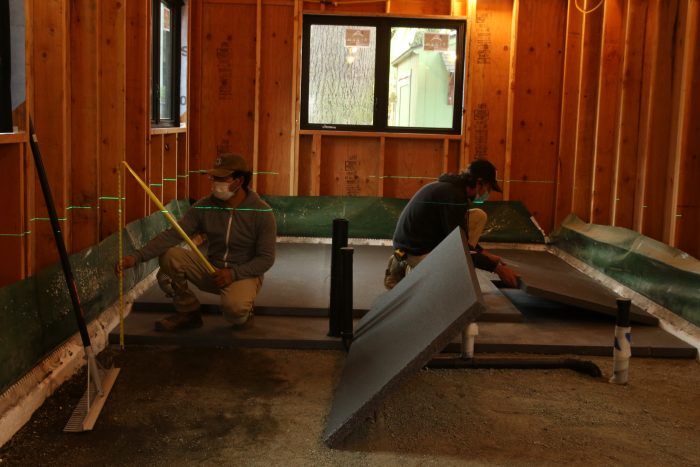Foundation Insulation Options for a Concrete-Free Slab
A plywood slab-on-grade requires a similar foundation construction to the ones used when building a traditional concrete slab-on-grade home.

There are several benefits to building a concrete-free, slab-on-grade home, including a reduction in embodied carbon, less flooring headaches, and faster completion times. When choosing to build a home with a plywood slab, the foundation construction and insulation options are similar to the ones used when building a traditional concrete slab-on-grade home. At Birdsmouth Design Build, we build our foundations using insulated concrete forms (ICF), but if you would rather not use ICFs, here are two additional options.
#1 Raise the insulation layer

If you’re okay with a step up into the home, you can simply raise the level of the horizontal insulation to be flush with the top of the stem wall (we also place a thin thermal break between the flooring and sill plate). This approach far and away exceeds minimum code requirements, but you’ll need to create a landing at the exterior door to avoid a short awkward step, and be sure to flash the threshold carefully to prevent water entry.
#2 Place a vertical foam layer inside the stem wall

To bring the finished flooring down level with the threshold (in keeping with universal design) while creating the code-required thermal break at the edge of the slab, extend the continuous layer of foam under the slab into an L-shape at the edges. The downside here is a slightly larger space between the plywood slab and the flooring, making it difficult to attach flooring at the perimeter.
If you would like to learn more about the benefits of a concrete-free slab, or if you would like to see the detailed step-by-step process that will demonstrate exactly how to build one, check out the full story here.
Josh Salinger is founder and CEO of Birdsmouth Design Build, a residential design-build firm in Portland, Ore. Photo by Asa Christiana. Drawings by Peter Wojcieszek.
RELATED LINK
Fine Homebuilding Recommended Products
Fine Homebuilding receives a commission for items purchased through links on this site, including Amazon Associates and other affiliate advertising programs.

Disposable Suit

Great Stuff Foam Cleaner

Utility Knife


























View Comments
My local building inspector would go crazy over this. We suffer tremendously from termites in North Georgia. I am extremely doubtful he would allow one layer of poly (capable of being torn unseen) to serve as the primary defense against all insects, not just termites. Would the authors please address this issue. Thank you.
I am not looking for a debate here, but this plywood slab floor is the most ridiculous thing I've ever seen.
Regardless of any merit this idea has, the one simple fact is that it will get water damaged. It is not a question of if but when. At some point in time, a water heater will fail, a dishwasher will fail, a toilet or sink will overflow, a washing machine hose will break etc. When a failure occurs, the flooding will buckle and delaminate the "plywood slab" at which point you will not only have to replace the finished floor but the layers of plywood as well.
As long as the floor has an opportunity to dry more than it gets wet, there should be no problem. If there is a constant water source then yes-- the plywood would certainly suffer from it. A one time event such as you mentioned should dry and go back to its original state. If there is a constant water source you have larger problems that should be addressed that are independent of the slab choice. The finished floor would have to be replaced whether the slab is concrete or plywood, so that argument is moot. Also, the plywood is easily cut with regular tools and can be replaced. Try doing that with concrete. If there is a sub slab plumbing break or leak, I would be very glad I had plywood instead of concrete.
I am planning to build a concrete-free slab and am finding that type 2 EPS foam is really expensive in my area. I'm wondering if you have looked into using a rigid rockwool board as insulation instead of foam. Would that be dense enough?